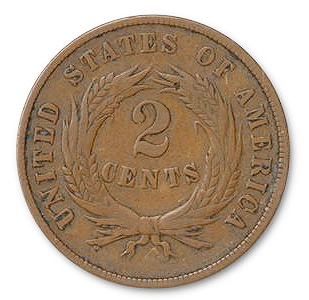 What is the value of what you produce at your business? How
do you decide what you will charge for what you do? Marketing will help you
determine your value.
What is the value of what you produce at your business? How
do you decide what you will charge for what you do? Marketing will help you
determine your value.
On this date in 1864, the U.S. Mint in Philadelphia began
distributing the two-cent coin. Back in those days, coins held the same value
as the metal used to mint them. Paper money was simply a note from the Fed
saying it could be exchanged for "real money” – metal coins. Paper was little
more than an IOU. Since the American Civil War was stretching the resources of
the government in 1864, many people began to horde coins in anticipation of a
recession and the Fed was running short on metal to be used for money. Congress
authorized the use of a brass coin – an alloy of copper and zinc – to make the
copper they had available to them to stretch. They also decided to stray away
from the metal value equivalency rule and authorize a two-cent coin made from
metals costing a fraction of a cent. The two-cent coin was produced for ten
years before being retired. Most of them were rounded up and melted down to
produce new pennies. However, some survived and remained in the hands of
private collectors. Today, a two-cent coin is worth anywhere from $15 – $20,000!
How can a small piece of brass that was struck using metal that was worth less
than a penny, and was circulated at a value of two cents, now be worth up to
1,000,000 times its stated value? First, there is a limited supply. They don’t
make two-cent coins any longer. Second, there is a target market in coin
collectors who are buying and selling rare coins. They create a demand for old
coins. Third, there are the opinions of published experts who gauge the quality
of coins and help set the price. In the middle of all these factors is
marketing.
When we are talking about defining the value of a product or
service, the term "marketing mix” is often used. What exactly is the marketing
mix? It is all of the different components of a marketing strategy to get a product
or service to market. One of the more
popular marketing mix strategies is called the Four Ps. This was developed by
Harvard Business School professor Jerry McCarthy over 60 years ago. The Four Ps
are Product, Price, Place and Promotion. Product is the way you define the
benefits of what you are selling. How does it solve a problem for your target
market? How unique is it? We wrap this up into a brand so the customer
understands with just a word what it is you are offering them. The more unique
and problem-solving your brand, the higher the value. Price is driven by the
perceived value of the brand and how it compares to other solutions in the
marketplace. Place is the location where your target market is most likely to
search for a solution to their problem. That may be the internet or that may be
in a coin store. Promotion is the way in which you inform the target market of
your brand. Promotion entices your customers to experience the other three Ps.
You promote to them the Place where they will experience the Product and Price.
Take away any of the four Ps and the other three will not work.
Marketing sets the value of what you do. The marketing mix
helps you define the uniqueness of your product/service, evaluate what it is
worth to your target market to solve their problem, place it where they can
encounter it, and communicate why they should buy from you.
There is my two cents! By the way, have you ever wondered
why that phrase came about? Why not, "There is my penny or my nickel?” Now you know
the story behind the phrase.